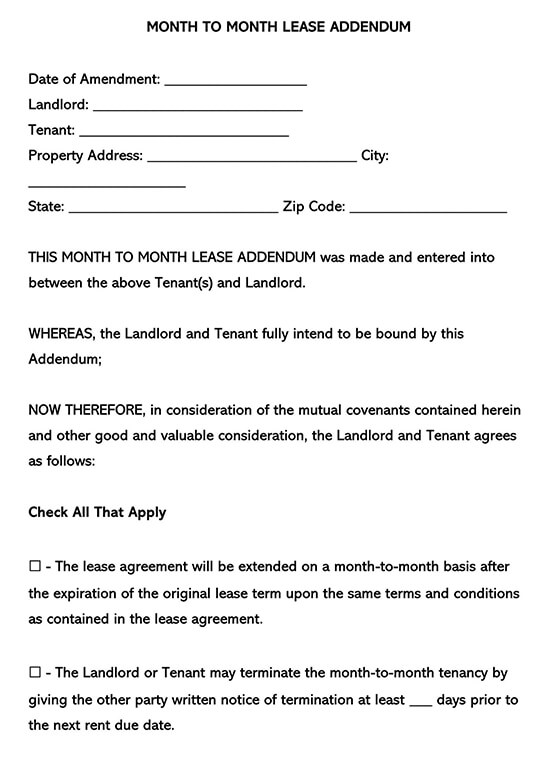There are times when a landlord or tenant may wish to make changes to an existing lease agreement, such as converting a fixed-term lease into a month to month lease or changing the amount of rent. This is done using a Month to Month Lease addendum.
Free Template

What is a Month to Month Lease Addendum
A Month to Month Lease Agreement is a document that is added to an original existing lease.
It must be agreed upon and signed by both the tenant and the landlord and can be used to adjust the lease terms on month by month basis if necessary. This can include monthly changes in rent rates, adjusting regulations regarding using the property, or allowing pets. Landlords may also use a month to month lease agreement as a way to give a new tenant a trial period before converting their month to month lease to a fixed-term lease.
Mainly, the purpose of an addendum is to cover any details that are not covered in the original lease document.
What is Included
While the reason for the addendum will differ in each situation, there are some key things that should be included in a month to month lease addendum:
- Name of the landlord
- Name of the tenant
- Address of the property being rented
- The date that the amendment was added
From here you can add the purpose of the addendum, such as a current month to month lease being extended, how termination notices are to be given, rent increases, changes requested by the tenant, or any other change that requires a written explanation.
Lastly, for the addendum to be valid, both the tenant and landlord need to sign the addendum and date it.
Tips For Writing an Addendum
- Each new addendum should be under its own topic, so be sure each one is properly titled and that you have included the term “addendum” to avoid confusion.
- If you have created a new addendum after a lease term has started, both the tenant and landlord must agree to the addendum before it can go into effect. A tenant is not obligated to agree to or sign a lease addendum that was made after the tenant has signed the original lease.
If a tenant does not wish to sign an addendum, a landlord cannot enforce it. However, once the term of the original lease has expired, landlords can require the addendum to be signed before renewing a rental agreement.
Benefits of Month to Month Lease Addendum
Aside from protecting the landlord, there are a few benefits that a month to month lease addendum offers:
- They can cover specified risks that were not covered in the original lease.
- They offer more flexibility, such as only using the addendum for certain tenants or rental properties.
- They can address new situations related to the rental property, such as adding a new pool or spa to the property. An addendum can be used to detail the use and maintenance of the new addition.
Some Common Lease Addendums
- Smoking – This allows you to enforce an environment that is smoke-free. The original lease should state that smoking in the property is prohibited, but you can create an addendum detailing any consequences or fees.
- Pets – Can be used to detail breed and pet types that are allowed, as well as any deposits or fees associated with allowing pets.
- Landscaping and Renovations – Can be used to detail whether a tenant is allowed to renovate or make changes to the property and outside areas.
- Guests and Occupancy – Can be used as a means of protecting the rental property from damage or fire hazards by limiting the number of guests allowed, and addressing any long-term guests and how long they are allowed to stay.
Required Legal Disclosures
Federal, local, and state laws have certain requirements regarding information and policies being disclosed in rental leases agreements. Addendums can be used to add new disclosures or address any that were not on the original lease document.
Both the EPA and HUD require landlords to include a disclosure in their leases if lead-based paints have been used in any of their properties that were built before 1978. Some cities and states also have disclosure requirements, such as for mold and asbestos.
Other things, such as existing damage before a tenant moves in, how deposits are held, rent control regulations, arrangements regarding shared utilities, and present health hazards, all need to be disclosed.
Frequently Asked Questions
A landlord can’t make changes to a term after the tenant has signed the lease. This means that any addendum won’t go into effect until the original lease term ends, and both the tenant and landlord have agreed to the new lease changes.
An addendum is used to add changes or details to an existing lease agreement. An amendment is used when a change is needed on an existing agreement.
No. A tenant is under no obligation to sign an addendum that has been presented after they have signed their original lease agreement.












